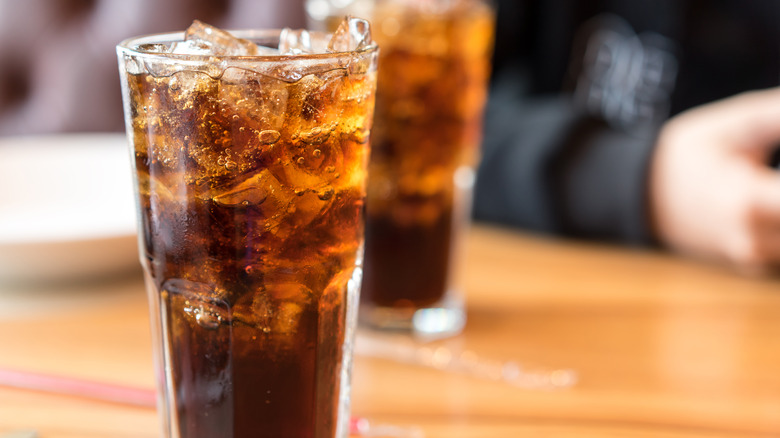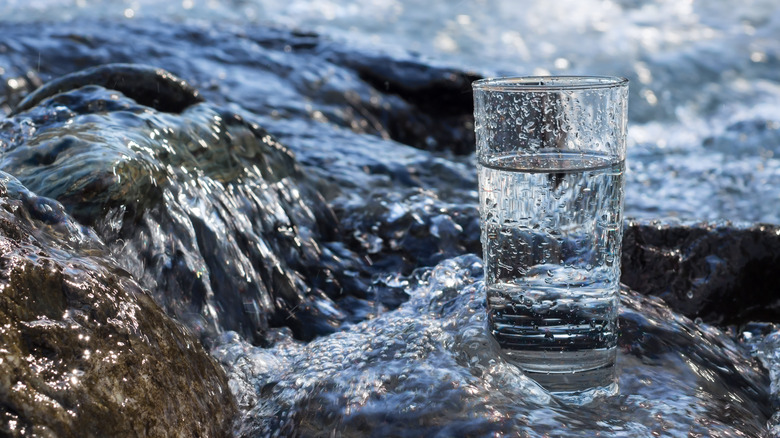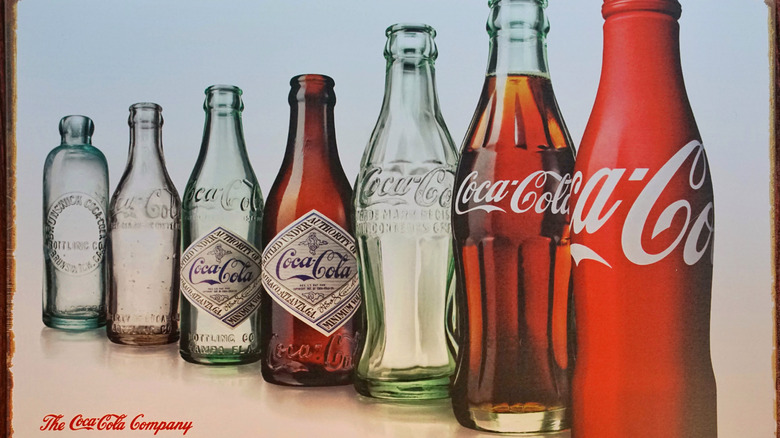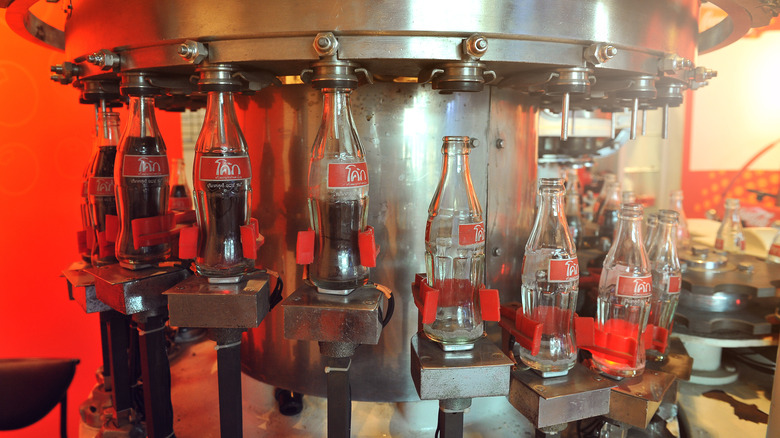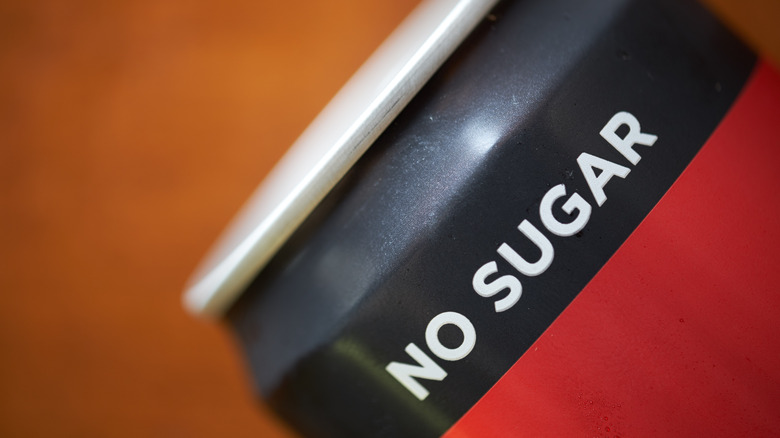The Fizzy Origins Of Soda
What do you call a fizzy, flavored beverage? Depending on where you hail from, the answer can vary. A 2018 survey from cartographer Alan McConchie (via Insider) focuses on three regional terms, each of which will leave outsiders shaking their heads in bewilderment.
"Soda" is the word of choice in the Northeast, Southwest, and Hawaiian Islands. Folks in the Midwest and Northwest lean towards "pop." Then you have the southern states, from Texas on over to Georgia, who call these refreshments "coke," whether or not the drink in question is Coca-Cola. (Yes, though it may shock the northern reaches of America, there are parts of the country where "Sprite is my favorite kind of coke" is a proper statement.)
Soda, as we'll be calling it here, is awfully popular. The global carbonated soft drink market was valued at $221.6 billion in 2020, according to Grand View Research. However, this popularity is one of the reasons that soda has become a key point of concern for the medical community. According to a 2012 CNN report, 25% of Americans consume at least 200 calories' worth of sugary beverages every day. What makes this fact particularly odd is that the soda industry evolved, in part, from a quest to make health drinks.
The pioneers of soda
The earliest instance of marketed soft drinks comes from 17th-century France. According to Britannica, the first soft drink company was the Compagnie de Limonadiers, founded in Paris in 1676. As you might guess from its name, the business dealt in lemonade, made from water, lemon juice, and honey.
There are two notable facts about this company that stand out. Firstly, its beverage was not bottled, but rather sold by vendors who walked the Parisian streets with tanks of lemonade on their backs, from which they could pour individual servings. Secondly, the beverage was not fizzy at all. The term "soft drink" was originally used to denote any flavored drink that was non-alcoholic, distinguishing it from "hard" liquor.
According to AmericanBeverage.org, carbonated beverages didn't come around until the 1760s. They were inspired by natural spring water, whose mineral content made it fizzy, per a report published in the journal Foods in 2019. Throughout Europe, health resorts were built around these mineral springs based on people's belief that bubbly water could cure an array of ailments (per McGill University). This inspired an English scientist named Joseph Priestley to invent artificially carbonated water, which he made by combining chalk and sulfuric acid to generate carbon dioxide that he then pumped into water using a pig's bladder. (Whenever you're feeling down about modern times, remember that you could be drinking pig bladder water.)
The rise of flavored soda
Joseph Priestley's carbonated water was said to have an unpleasant flavor. Gee, what could that be about? Oh yeah, he was using a pig bladder. Thankfully, per McGill University, a Scottish physician named John Nooth invented a glass apparatus that could do the job.
Early fizzy water was also quite acidic (remember that sulfuric acid was originally used for carbonation). Sodium salts were added to the water to balance its pH, and according to Dictionary.com, this is how the word "soda" originated. Mass production of carbonated water began in the early 1800s. The soda fountain was patented in 1819 by Samuel Fahnestock, and in 1835, bottled soda became available in the United States. Around the same time, people started jazzing up the drink with a variety of flavors, notes the Science History Institute.
It's unclear where the first flavored fizzy water came from. But by the end of the 1700s, it was popular to mix carbonated water with wine. ThoughtCo notes that non-alcoholic flavorings emerged in the 1830s, with bubbly lemonade debuting in 1833. The latter half of the 19th century saw the invention of ginger ale, root beer, and Dr. Pepper, which claims to be the oldest soda brand in the United States. The most famous development in flavored sodas came in 1886, when J.S. Pemberton invented Coca-Cola. Originally conceived as an alternative to morphine, its flavor initially came from a combination of African kola nuts and South American cocaine.
Soda went mainstream in the 20th century
The soda business rapidly expanded around the turn of the 20th century. According to ThoughtCo, there were 123 soft drink bottling plants in the United States in 1860. By 1900, that number had grown to 2,763.
This massive growth in business was propelled by a series of important technological advancements that came about during the Second Industrial Revolution, which lasted from 1870 to the beginning of WWI in 1914. The most important was the invention of the familiar crown bottle cap, now a ubiquitous feature of soft drinks and beer. According to the Dr. Pepper Museum, the cap was invented by William Painter of Baltimore, who also invented a bottling machine and bottle opener to go with it.
The soft drink business found an unexpected ally in the temperance movement. According to The Atlantic, sales of soda increased by a whopping 200% over the first six months of Prohibition, but it wasn't necessarily a substitute for liquor. During America's dry years, the only accessible alcohol for many people was moonshine, which tended to be harsh — and sometimes even toxic. To cut the burn, people started combining moonshine with ginger ale, establishing the popular practice of using soda as a mixer. Ginger ale reportedly became so popular during this era that Al Capone got in on the racket, setting up a series of bottling plants in Chicago to establish a monopoly on the mixer market.
The game-changing advent of diet soda and corn syrup
The first diet soda was invented in 1952 and was intended for diabetics. It was called No-Cal, and its inventor, Hyman Kirsch, used an artificial sweetener in place of sugar. According to Fast Company, No-Cal ultimately found greater success outside the diabetic community when dieters picked up on it.
Other soda companies jumped on the train, and in 1963, Coca-Cola released its first diet beverage, Tab. Per The Library of Congress, Tab wasn't particularly popular, so Coca-Cola decided it needed a diet drink that retained its signature trademark. Diet Coke debuted in 1982, and by the next year, it was the top-selling soft drink in the United States. (Still, time has revealed that diet sodas bring plenty of health risks, too.)
Meanwhile, regular Coke and other non-diet sodas ditched sugar in favor of high-fructose corn syrup. The Library of Congress notes that it was much cheaper than cane sugar, leading Coca-Cola to phase out sugar in 1980. It was a turn for the worse in terms of public health, as fructose has been linked to the production of fat cells, per Slate. However, CNN notes that there was a 17.3% drop in soda consumption between 1998 and 2012.
